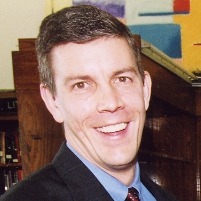Secretary of Education: Who is Arne Duncan?
Monday, December 29, 2008

If confirmed, Arne Duncan would become the first Cabinet member who has earned a living playing and coaching basketball. Duncan was born on November 4, 1964, to Starkey Duncan, a psychology professor at the University of Chicago, and Susan Morton, who has operated The Sue Duncan Children’s Center on the south side of the city. He was raised in the Hyde Park area of Chicago and attended the University of Chicago Laboratory Schools, before going on to Harvard. Duncan graduated magna cum laude with a bachelor’s degree in sociology in 1987. His thesis was titled, “The Values, Aspirations and Opportunities of the Urban Underclass.”
Standing six feet, five inches, Duncan was co-captain of Harvard’s basketball team and was named a first team Academic All-American. He had dreams of playing in the NBA and received a tryout with the Boston Celtics. After failing to land a spot with the Celtics, Duncan played professional basketball in Australia from 1987-1991 with the Eastside Melbourne Spectres, the Launceston Ocelots and the Devonport Warriors, which he coached. While living down under, he worked with underprivileged children and met his current wife, Karen, who is Australian. They have two children.
Duncan’s first professional opportunity outside of basketball came from his childhood friend, John W. Rogers, Jr., CEO of Ariel Investments and founder of the Ariel Academy and the Ariel Education Initiative. Duncan took over as director of the Ariel Education Initiative in 1992, helping guide the organization that seeks to create educational opportunities for inner-city children on Chicago’s South Side.
Some of Duncan’s other childhood friends are Illinois state Senator Kwame Raoul, actor Michael Clarke Duncan, singer R. Kelly and martial artist Michelle Gordon.
In 1998, Duncan joined the Chicago public schools system (third largest in the country) as director of magnet schools and programs. He was then promoted in 2000 to deputy chief of staff of the school system, and a year later elevated again to CEO. While head of Chicago’s schools, Duncan has not shied away from controversy. His decision to close failing schools and use unconventional methods to increase academic performance has often met with resistance from the community. He has been a strong advocate for charter schools, performance pay for teachers, sex segregated education, and funding increases for No Child Left Behind. He also supported a proposal for a high school catering to gay students, called Pride Campus.
In 2000, 76% of Chicago public school students showed up for class on the first day of the year. By 2003, the rate was 89%. Duncan has sent district representatives to students’ homes to urge them to attend and offered tickets to sporting events to lure students to school. First-day attendance levels help determine year-long state funding levels.
Statistics haven’t always demonstrated success for Chicago’s schools under Duncan’s watch. In 2005, a report by the University of Chicago found that only 54% of high school seniors were graduating—a rate far below the 71% reported by Chicago school officials.
Many in the education community reacted positively to Duncan’s selection as Secretary of Education. But there were detractors. As The New York Times pointed out, Duncan, has “little of the national political experience that education secretaries often need in representing the White House’s educational agenda before Congress and negotiating with the leaders of the 50 state school systems and the myriad interest groups that make up the educational establishment.”
Duncan and Obama have played pickup basketball games together in Chicago since they met through Michelle Obama’s brother in the early 1990s. Duncan has reportedly played pick up games with Michael Jordan, and was among a select few to play ball with Obama on Election Day.
Arne Duncan (New York Times)
The Duncan Doctrine: The Military-Corporate Legacy of the New Secretary of Education (by Andy Kroll, TomDispatch)
Aussie lessons for Obama's school tsar Arne Duncan (by Stuart Rintoul, The Australian)
Education Secretary Arne Duncan (by Kate Pickert, Time)
Obama’s Betrayal of Public Education? Arne Duncan and the Corporate Model of Schooling (by Henry A. Giroux and Kenneth Saltman, Truthout)
Tracking an Unusual Inner-City Talent (by Jonathan Putnam, Harvard Crimson)
- Top Stories
- Unusual News
- Where is the Money Going?
- Controversies
- U.S. and the World
- Appointments and Resignations
- Latest News
- Musk and Trump Fire Members of Congress
- Trump Calls for Violent Street Demonstrations Against Himself
- Trump Changes Name of Republican Party
- The 2024 Election By the Numbers
- Bashar al-Assad—The Fall of a Rabid AntiSemite






Comments